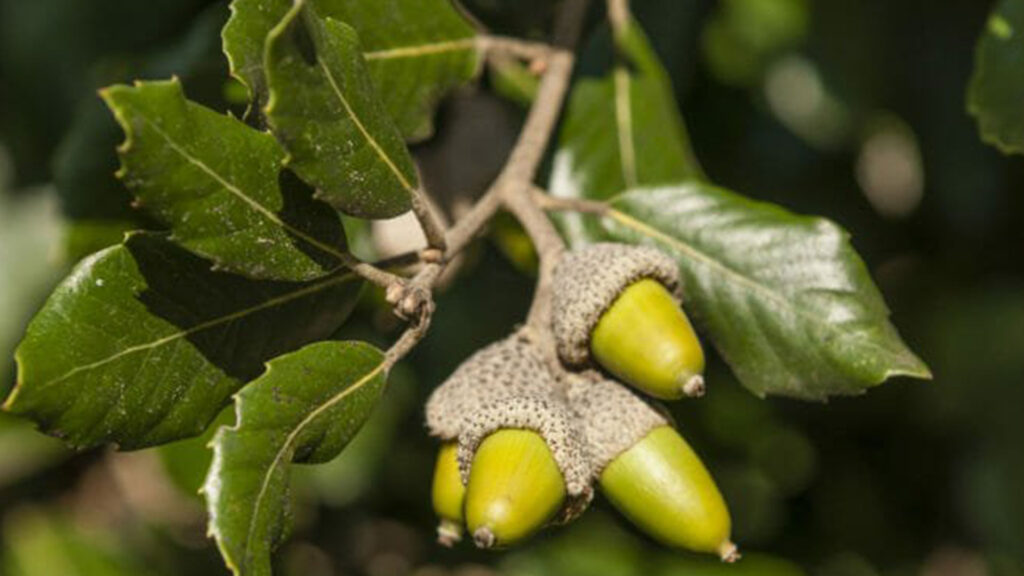
Leccio
Appartiene alla famiglia delle Fagaceae, ha un portamento arboreo con chioma densa e ampia , può arrivare fino a 25/30 mt in altezza, sia nelle zone montane sia a livello del mare.
Chiamato anche ELCE ( QUERCUS ILEX) è uno dei principali rappresentanti dei querceti sempreverdi dei paesi del mediterraneo ,da non confondere con la quercia da sughero, vegeta in clima temperato, molto diffuso in Sardegna forma boschi puri o misti con roverelle e sughere. E’ una pianta a crescita lenta ma molto longeva , può vivere fino a qualche centinaio di anni.
Si adatta facilmente a tutti i substrati purchè non troppo umidi, resiste a condizioni climatiche anche di siccità prolungata e freddo intenso, riesce a crescere persino su terreni sottoposti a pascolo intensivo , dove, con un meccanismo di difesa la pianta si riduce ad un arbusto per tenere lontani gli animali che ne mangerebbero le foglie.
In giovane età la pianta ha la corteccia liscia grigia che diviene rugosa e brunastra negli esemplari adulti. Le foglie sempreverdi hanno forma variabile lunghe da 3 a 7 cm, provviste di un piccolo picciolo, quelle giovani sono dentate, spinose di colore scuro nella parte superiore e più chiaro nella parte posteriore. La fioritura avviene in aprile/maggio, i fiori maschili sono riuniti in amenti penduli, quelli femminili in infiorescenze erette a spiga. I frutti sono delle ghiande ellissoidali avvolte per un terzo dalla cupola , maturano tra maggio e settembre, sono piu dolci rispetto a quelle della quercia e vengono usate come mangime per i suini. Ancora oggi in Spagna le ghiande del leccio sono il pasto principale per i maiali destinati alla produzione del famoso prosciutto iberico (JAMON SERRANO).
Viene coltivato anche a scopo ornamentale in giardini botanici e privati ,anche come pianta da siepe perfetta per realizzare muri verdi o frangivento.Il legno e’ apprezzato come combustibile per legna da ardere e da carbone.
Holm oak
It belongs to the Fagaceae family, it has an arboreal habit with dense and broad foliage, it can reach up to 25/30 meters in height, both in mountainous areas and at sea level.
Also called ELCE (QUERCUS ILEX) it is one of the main representatives of the evergreen oak woods of the Mediterranean countries, not to be confused with the cork oak, it grows in a temperate climate, very widespread in Sardinia, it forms pure or mixed woods with downy oaks and cork oaks. It is a slow growing but very long-lived plant, it can live up to a few hundred years.
It easily adapts to all substrates provided they are not too humid, it resists even climatic conditions of prolonged drought and intense cold, it can even grow on land subjected to intensive grazing, where, with a defense mechanism, the plant is reduced to a shrub for keep away the animals that would eat the leaves.
At a young age the plant has a smooth gray bark which becomes wrinkled and brownish in the adult specimens. The evergreen leaves have a variable shape from 3 to 7 cm long, provided with a small petiole, the young ones are toothed, spiny, dark in color above and lighter in the back. Flowering occurs in April/May, the male flowers are gathered in pendulous catkins, the female ones in erect spike inflorescences. The fruits are ellipsoidal acorns wrapped for a third by the dome, they ripen between May and September, they are sweeter than those of the oak and are used as feed for pigs. Even today in Spain the acorns of the holm oak are the main meal for the pigs destined for the production of the famous Iberian ham (JAMON SERRANO).
It is also cultivated for ornamental purposes in botanical and private gardens, also as a hedge plant perfect for creating green walls or windbreaks. The wood is appreciated as fuel for firewood and charcoal.
Chêne vert
Il appartient à la famille des Fagacées, a un port arboricole au feuillage dense et large, il peut atteindre jusqu’à 25/30 mètres de hauteur, aussi bien en zone montagneuse qu’au niveau de la mer.
Aussi appelé ELCE (QUERCUS ILEX) c’est l’un des principaux représentants des bois de chênes verts des pays méditerranéens, à ne pas confondre avec le chêne-liège, il pousse dans un climat tempéré, très commun en Sardaigne, il forme pur ou mixte bois de chênes pubescents et de chênes-lièges. C’est une plante à croissance très lente mais en même temps très vivace, elle peut vivre jusqu’à quelques centaines d’années.
Elle s’adapte facilement à tous les substrats tant qu’ils ne sont pas trop humides, c’est une plante très résistante aux conditions climatiques de sécheresse même prolongée et de froid intense, elle peut même pousser sur des terres soumises à un pâturage intensif, où, avec un mécanisme de défense, la plante est réduite à un arbuste pour éloigner les animaux qui mangeraient ses feuilles.
À un jeune âge, la plante a une écorce lisse et grise qui devient ridée et brunâtre chez les spécimens adultes. Les feuilles persistantes ont une forme variable de 3 à 7 cm de long, munies d’un petit pétiole, les jeunes sont dentées, épineuses et de couleur foncée dans la partie supérieure et plus claires dans le dos. La floraison a lieu généralement au mois d’avril/mai, les fleurs mâles sont regroupées en chatons pendants, les femelles en inflorescences en épis dressés. Les fruits sont des glands ellipsoïdaux enveloppés pour un tiers par le dôme, ils mûrissent entre mai et septembre, ils sont plus sucrés que ceux du chêne et ils sont utilisés comme aliment pour les porcs. Aujourd’hui encore en Espagne, les glands du chêne vert constituent le repas principal des porcs destinés à la production du célèbre jambon ibérique (JAMON SERRANO).
Il est également cultivé à des fins ornementales dans les jardins botaniques et privés, également comme plante de haie parfaite pour créer des murs végétaux ou des brise-vent.Le bois est apprécié comme combustible pour le bois de chauffage et le charbon de bois.


